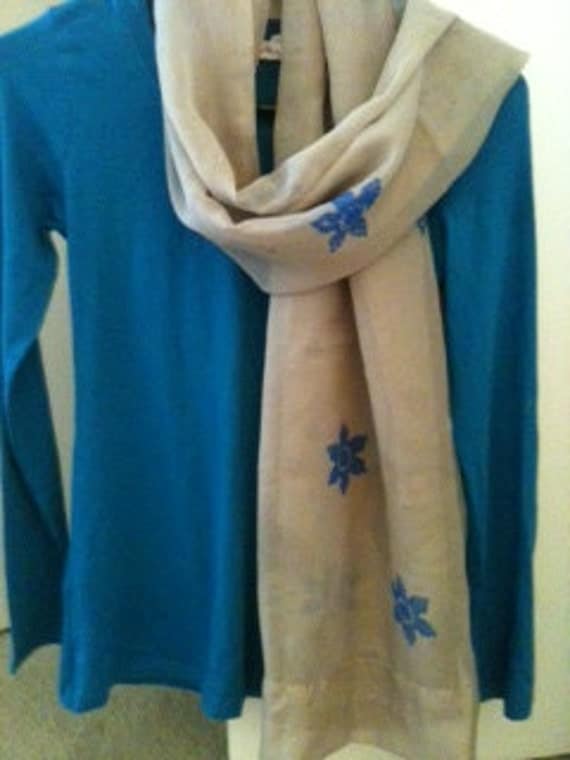Few colors and a suitable brush, fabric painting opens up endless opportunities for transforming your wardrobe and your home. It enables you to create one-of-a-kind pieces of wearable art (t-shirts are the most common) or to design some special cushion covers, curtains,scarfs or tote bags.
Techniqes of fabric painting includes Stenciling, Block printingand Free hand Painting.
Lets start with fabric stenciling
FABRIC STENCILING
.JPG)


These trendy stencils are great for stenciling your own designer pillows or curtains or transforming garage sale furniture finds into cool decorative pieces. Decorative possibilities are endless with these versatile reusable stencils!
Fabric Stenciling Basics:
Best fabric for painting on is 100 per cent cotton with a tight weave But good results can be obtained with rayons and silks too. The best is to try a sample square to check the results.
Natural sponges are excellent tools for controlling the amount of pigment applied. Dab the paint-filled sponges lightly with vertical pressure.There are many paints designed specifically or painting on fabric. Regular craft acrylics can be turned into suitable fabric painting mediums with the simple addition of Textile Medium. Heavier fabrics will not move much as you stencil, but lighter fabrics can be held in place for stenciling by working on a smooth cardboard surface that has been lightly sprayed with stencil adhesive. Using stencil adhesive to maintain your stencil in position is also very helpful.If washing the item in the future, the easiest way to heat-set your stenciled fabric is to place the item in the dryer on high heat for an hour. Otherwise, you can heat set the painted area with a hot, dry iron and pressing cloth for a minute or two. A stippling or pouncing technique can be used with the stencil brush to work the paint well into the fibers.
Basic fabric -printing supplies
Self Healing Mat- Place the mat under the fabric
Template/Stencil
Fabric Paint-
Natural Soft Sponge
Foam Paintbrush / Rollers
Paint Palette
Method
Cover a work surface with kraft paper and tape the fabric on top. Prewash the fabric. Lay the stencil on the area of the fabric you wish to embellish. If you wish to mix colors to create a custom shade,do so on the palette. With a clean sponge,dab the paintinsidethe stencil. In general, its best to work left to right top to bottom. Let dry about 3 minute. Once you finish stenciling, set paint with an iron.
Fabric Free hand painting
A super cool and interesting idea to get all your fabrics trendy and stylish is to paint it yourself and personalize it. Check out some awesome techniques and designs you can go for.
Preparing Fabrics for Painting Designs
There are points you need to take care of before you start painting designs on fabrics. It includes:
1. It’s better to choose 100% cotton fabric for beginners to start painting.
2. Pre-wash fabric you want to paint, so that all the starch is removed from the piece of cloth and it does not shrink after you paint and wash it.
3. Finally, iron your fabric to make it wrinkle-free so that it doesn’t havoc designs.
Important Tip:
To check if the fabric is ready to be painted, pour a drop of water on cloth….if the water droplet is absorbed that means it is ready to be painted directly. If the water drop beads up, it means you need to wash your piece of cloth.
And now you are ready to paint! Let’s get started…
How to Start Painting on Fabric
Since now your fabric is ready to be painted, you can either apply fabric paints directly and make free-hand designs or follow the following steps;
1. Choose a pattern or design you want to imprint on your fabric and draw it on a sheet of paper.
2. Lay a carbon paper on your selected piece of cloth where you want to paint . Now, imprint the design you have already made on paper by outlining it.
3. Use wooden embroidery hoops (easily available in the market) to the area you want to paint on.
4. Use fabric paints directly using round paint brush (for beginners) and start painting your fabric in flow with the design and let it dry.
Tip: If you are artistic enough and want to go or free hand painting, make sure the you lay a newspaper right below the area you want to paint so that the colors don’t get down on the second layer of cloth.

.JPG)
.JPG)
.JPG)

.JPG)
.JPG)
.JPG)
.JPG)



.JPG)
.JPG)
.JPG)
.JPG)
.JPG)
.JPG)
.JPG)
.JPG)
.JPG)
.JPG)
.JPG)
.JPG)
.JPG)
.JPG)


.JPG)
.JPG)
.JPG)



.JPG)

.JPG)

.JPG)
.JPG)
.JPG)
.JPG)
.JPG)

.JPG)
.JPG)





